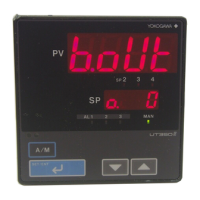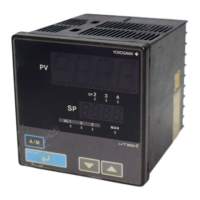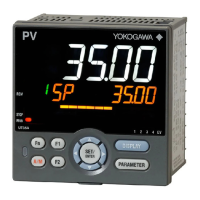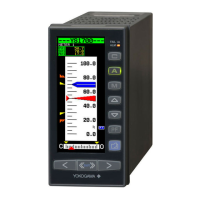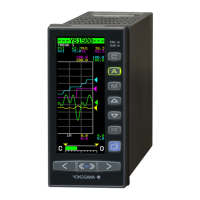IM 04L20A01-01E 1-47
1
Explanation of Functions
Report Function
This function is used to create hourly, daily, weekly, and monthly reports. The report
data can be displayed on the screen.
Types of Reports
• Hourly report
On every hour on the hour, the average, maximum, minimum, and sum values of the
specified channels are determined from an hour of data up to the current hour and
stored to the internal memory.
• Daily report
At the specified time everyday, the average, maximum, minimum, and sum values of
the specified channels are determined from a day of data up to the specified time and
stored to the internal memory.
• Weekly report
At the specified time of the specified day every week, the average, maximum,
minimum, and sum values of the specified channels are determined from a week of
data up to the specified time and stored to the internal memory.
• Monthly report
At the specified time of the specified date every month, the average, maximum,
minimum, and sum values of the specified channels are determined from a month of
data up to the specified time and stored to the internal memory.
Report Data Display
For a display example of report data, see page 1-25.
Combinations of Reports That Can be Created
The reports created by the FX100 can be set to “hourly only,” “daily only,” “hourly and
daily,” “daily and weekly,” or “daily and monthly.”
Number of Measurement and Computation Channels That Can Be Assigned to the
Report
Up to 12 channels can be assigned to one report.
The report data are not created for channels that are set to Skip or those that have
the computation turned Off.
About the Sum Scale
In the sum computation, data are summed over the scan interval. However, for flow
values that have units /s, /min, /h, or /day a simple summation results in the actual
value not matching the computed result, because the scan interval and the unit of the
input values are different. In these cases, the unit of the data measured over the scan
interval is converted to match the unit of the input values and the computation is
performed.
For example, if the scan interval is 2 s, and the input value is 100 m
3
/min, a simple
summation would add 100 every 2 s resulting in 3000 after one minute. However, if
the sum unit is set to /min, then 2 s/60 s is multiplied every scan interval before the
value is added giving a result that has a m
3
/min unit. The following equations are
applied. The scan interval unit is in seconds.
Off ∑(measured value)
/s ∑(measured value) x scan interval
/min ∑(measured value) x scan interval/60
/h ∑(measured value) x scan interval/3600
/day ∑(measured value) x scan interval/86400
1.6 Computation Function and Report Function (/M1, /PM1 Option)

